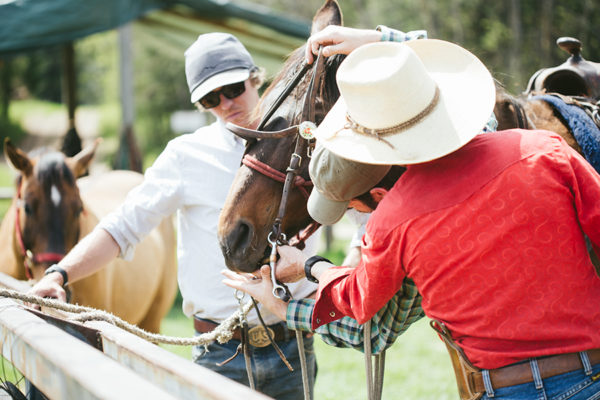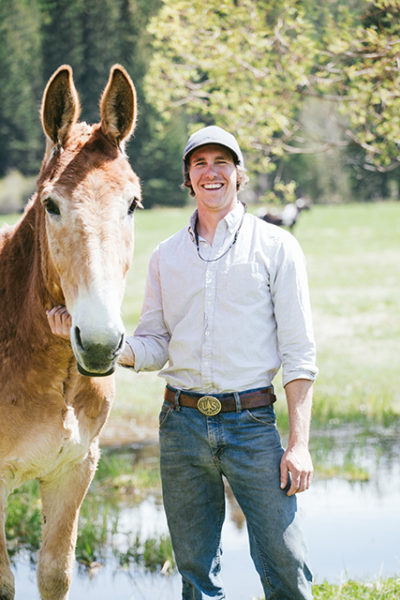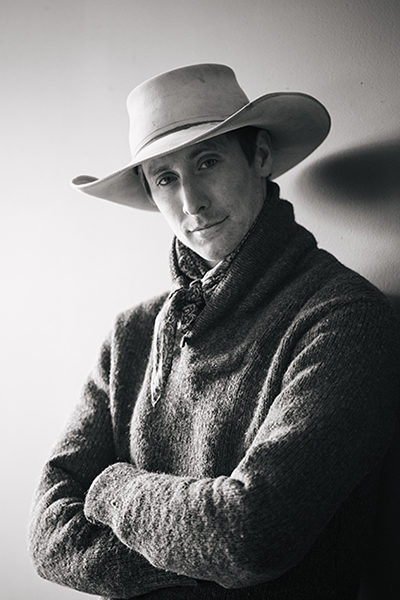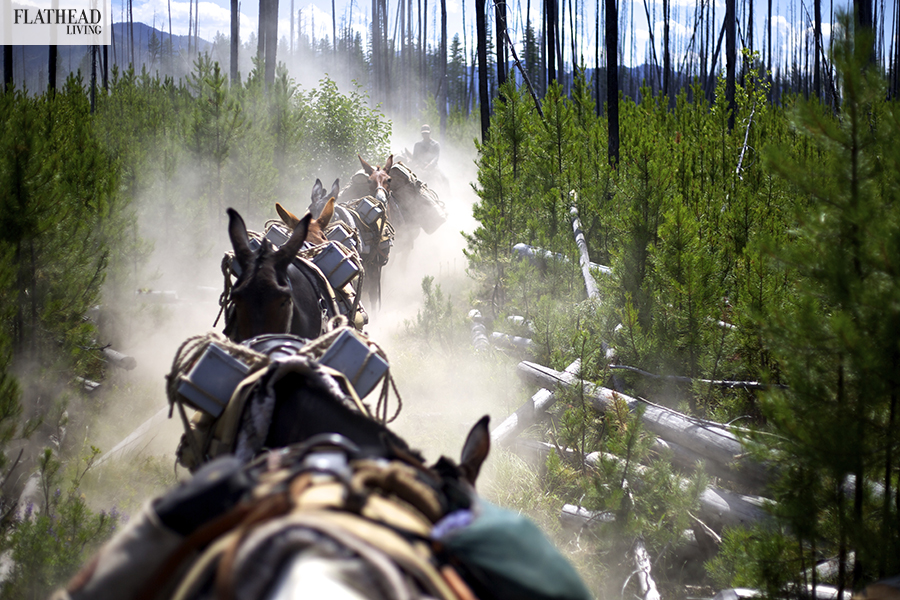A painted horse and four mules lick at a block of salt at the Coram Corral in Martin City. Four other mules wade in the nearby creek. Another smiles as Michael Reavis massages his pointy ears. Fifty-five more nibble grass. It’s hot, high 70s, and there’s no wind to rustle the lime-green aspens. Even the slow-moving clouds look sun-sapped. Reavis stops petting the mule, and tufts of his old winter coat float through stale air.
A few decades ago, more than 100 mules might have roamed this pasture, where the U.S. Forest Service’s Spotted Bear Ranger District accommodates its livestock in the weeks ahead of summer’s working season. The herd is smaller now. The diminishing numbers reflect a trend in packing, the art and trade of loading mules with supplies and leading them deep into wild lands so people can work or recreate. Packing is dying, if you believe the campfire stories.
Old-timers say the golden era ended in the 1970s. Its forefathers and mothers are fading away or already gone. They passed along much of their hard-won wisdom, but their pupils are fewer, still young, and, when experience is measured in decades, green. Government funding is harder to come by, so districts own less stock and hire a fraction of the human hands to lead pack strings, which is shorthand for a team of nine mules led by a packer on a horse. Roads reach farther than they did a century ago. Helicopters, though expensive, can haul more gear, and faster, than a string.
And although American recreationalists are exploring natural areas in increasing numbers, it’s by foot, not by hoof. Packing by private citizens is headed the way of the stagecoach and steamboat. It’s no longer a fact of rural living to keep and work livestock, so most Montanans don’t — it’s expensive and time-consuming.
Yet here’s 27-year-old Reavis, Spotted Bear’s assistant full-string packer, standing in the pasture in his dusty Wrangler jeans. The district’s lead packer, 62-year-old Bill Workman, is over by the creek. The mules gravitate toward them. Workman pulls chewing tobacco from his breast pocket and blinks at the flies. He wears an unwrinkled strawberry-red shirt, a 1986 Cole ranch rodeo champion belt buckle, and a cowboy hat with a small American flag pin. His border collie, Duke, runs circles around the livestock.
“There got to be less packers,” Workman acknowledges. Even so, he continues, “What we do back here won’t ever change.”
There are thousands of miles of trail in the Flathead National Forest, Bob Marshall Wilderness Complex (where mechanized travel is prohibited), and Glacier National Park, and they require trail and fire crews to venture into their furthest reaches with gear too cumbersome to transport on human backs. Without packers — professionals, as well as volunteers on stewardship trips — these backcountry trails would go unmaintained and drop offline.
A new generation of packers is rising up in Northwest Montana. It includes Reavis, as well as Guy Zoellner, the 37-year-old trails manager at Spotted Bear; Karl Crittenden, the 32-year-old packer at the West Fork Ranger District in the Bitterroot National Forest; Robin Connell, the 33-year-old packer on the east side of Glacier National Park; Doog White, the 31-year-old packer at the outfitter Wilderness Lodge; and Dawson Chute, White’s 18-year-old mentee.
Depending on their employer, their primary duty is to pack trail crews, or clients, in and out of remote locations, transporting food and supplies. They’re aware of their greater responsibility, of the role they play in passing down tradition. They’re humbled by it. Toughened by years on the trail and sweetened by true friendship with stubborn mules, if anyone can usher packing into a new era, it’s them.

An early May morning at the Coram Corral comes on slow. The mountain passes are still too snowy to cross. The to-do list is short. The day before, Reavis and Workman repaired fences, branded stock, and gave haircuts.
“Do we want to work, or do we want to BS?” Workman asks.
“BS-ing is probably easier,” Reavis says. He sips black coffee from his ceramic mug and pokes at his gums with a toothpick.
They decide to fix a gatepost broken last winter by a plow driver. They’re matching, in boots, blue jeans, neat button-up shirts, and vests. Reavis says Workman could wear a white shirt in summer, pack a big trip, and at the end of the day, “there won’t be a fleck of dust on it.”
Reavis is from Kila. Unlike Workman, whose father and grandfather packed for Glacier National Park and the Forest Service, Reavis didn’t grow up around livestock. In 2009, he took a job with the Big Prairie trail crew and began working with mules.
“Back then, it was strictly utilitarian for me,” he says. Then he met Workman, and livestock management took on a “whole new meaning.” Reavis worked trails until 2014, and in 2015, he began packing full-time. In 2016, he landed the assistant full-string packing position out of Spotted Bear.
He learned that there’s a distinction between people who pack and packers. People who pack move the gear from point A to point B. To pack every single day, to do it efficiently, and to take excellent care of the mules, is different.
“A packer takes pride in his stuff, his mules, the way he looks,” Workman says. “[People ask,] ‘Why do you trim them mules?’ It looks slick and neat. You could have a bunch of ratty-haired mules running around; you’d still get the job done. Have a little bit of pride.”
Rather than using modern pannier bags, professional packers use canvas tarps to custom-wrap gear for each trip. That’s called mantying. They’re attentive to how freight weighs on the mules, if it’s unbalanced, even a little bit. They summon patience when things go south — and they will go south. When the string wrecks, the pros don’t blame the stock. Reavis says he covers some 1,000 miles a season for work. He estimates that Workman has traveled a distance equivalent to circling the earth a handful of times. All the while, they put the animals’ needs before their own.
“When you get in, and you’re dead-dog tired, the most important thing is to take care of the horses and the mules first,” Reavis says. “They’ve been taking care of you all day.”
Around 1 p.m., a new Forest Service employee arrives at the corrals for a refresher on handling stock. While Workman eats lunch in the shade, Reavis takes over the lesson. He demonstrates how to slide the bridle onto a horse named JD. First, Reavis rubs JD’s cheeks, warming him to the touch. He slips the bit into JD’s mouth, places his palm on JD’s forehead, and tucks the headpiece over his ears — first the left ear, then the right. Reavis tightens the rosette and arranges JD’s mane around the browband. The hire tries to replicate his easy movements. Workman finishes his burger and resumes the tutorial.
“It’s nice to soak it all in, listen to [Workman’s] stories,” Reavis says later. “You get a lot of nostalgia out of that … There’s a lot to want to emulate. You want to respect the tradition and look professional, leave someone with the skills you learn over a lifetime, and send them on their way, knowing that the program’s in good hands.”

Years ago, a group of volunteer packers sat around a campfire near the North Fork Sun River in the Bob Marshall Wilderness.
“We were talking about the future of the trade, of packing skills,” Frank Vitale, the 65-year-old Bob Marshall Wilderness Foundation “master packer” and horseshoe farrier, says. “Not that they’re totally getting lost but … I’ve covered lots of miles in the backcountry, and I don’t see lots of young people out there pulling a pack string. That raised some concerns.”
Later, at a cabin in the Badger-Two Medicine Area, that conversation grew into the concept for a packer apprenticeship program hosted by the foundation. It launched in summer 2016 with two apprentices. Vitale says the first season was a success, and a good investment. The foundation, which reports a $395,000 annual income, spends $2,145 per apprentice to cover the costs of training and more.
“Packing is pretty cost prohibitive for young people, even if, deep down, they want to learn,” Vitale says.
Vitale and other members of his generation turn readily to technology, after cost, as the leading culprit for declining participation in packing.
“It is a less likely skill for young people to take up, because they can make more money in electronics and other businesses,” says Smoke Elser, the legendary 83-year-old packer who has taught the trade to thousands at Lolo National Forest’s Ninemile Wildlands Training Center. He notes that fewer of his students were raised on ranches and baseline horsemanship skills have decreased.
Elser also blames millennial laziness. So does his peer, Ron Stuber, the 78-year-old longtime officer of the volunteer packing group Back Country Horsemen of Montana.
“To run a pack string is a lot of hard work,” Elser says. “Back-aching work.”
“Young people today, they don’t want to work,” Stuber agrees. “Their interest is computers and electronics … We cannot seem to get young people interested.”
But even if half of the millennial generation is glued to computer screens, that means half of it isn’t. People drawn to wild lands like Stuber — and Reavis — won’t be deterred by the hard work it takes to get there. They didn’t get in this game for the money.
“The reason I do this is because I love the country,” Elser says. “The country is my heart and soul.”
Of young professional packers like Reavis, Elser adds, “I think they’re true to the spirit. They want to do the right job … We’re hoping that they’ll pass that on to younger generations. That’s the point. They have to pass it on, or we’re going to lose it.”
Until then, or until he can no longer teach, Elser will keep mentoring new students. He teaches week-long seminars at Ninemile, as well as an accredited, eight-week course at the University of Montana.
Stuber, meanwhile, says youngsters aren’t showing up to volunteer clinics. He can’t find a single card-carrying Back Country Horseman under the age of 40 on his membership logs.
“Right now, I don’t see anything [that inspires hope,]” he says. “It’ll just go by the wayside, and it’ll become history.”
Guy Zoellner, Karl Crittenden, and Robin Connell sit outside on the deck at the Montana Tap House in Whitefish. The sun is setting, and they face directly into its bright rays. They consider the future of their profession.
“Make no bones about it, what [packers do is] one of the most romantic, idealistic, subsidized lifestyles,” Zoellner says. “For me to be able to live here, and ride up in these mountains, and have it pay the bills, and be in a legitimate profession that I can call a living — I think we’re all pretty lucky that there’s a spot for that.”
Whitefish-born Zoellner inherited horsemanship from his family; his mother ran the Big Prairie trails program, and his grandfather was a packer. Right after high school, Zoellner’s mother loaned out his labor to the Spotted Bear trail crew. “I was totally ruined,” he says, for anything except the wilderness. He studied forestry in college, and then after six years on trails for the Seeley Lake Ranger District and in Glacier National Park, he began packing for Workman at Spotted Bear. He kept that job for seven years before shifting to trails manager, where he works with stock, though not exclusively.
Crittenden, a Whitefish native, was also introduced to packing through family, during annual hunting trips with his dad. His career also kicked off with a trail maintenance job at Spotted Bear, and was also inspired by a certain lead packer. He took a job in Wyoming’s Shoshone National Forest, then found his way back to Montana in 2015, taking over after a Bitterroot National Forest packer retired.

Connell was born in St. Ignatius. When he was 23, he got a job guiding fishing trips on the South Fork Flathead River for the Wilderness Lodge, where he learned to handle stock. He stayed on with the outfitter into the hunting season, and his position evolved into full-time stock management.
“The options were that I dealt with people or mules,” he says. “I chose mules.”
He then worked as an independent stock contractor, and in Idaho’s Payette National Forest. Last summer, he signed on at Glacier National Park. In his 20s, Connell says his goal was to have as much fun as he could. That usually happened in the woods while fishing and packing.
“Not until seven years into doing it did I actually feel like this was a career choice,” he says. “I just kept doing it.”
It’s not long before conversation at the Tap House turns to packing’s roots, to the 1970s and before. These packers weren’t born yet — still, they’ve all heard the stories.
“It almost faded from the culture, in a way,” Crittenden says. “It’s not part of life in the West.”
“Everybody had a horse. That’s the way people used to see the park,” Zoellner agrees. “I think it’s fallen out of vogue, a little bit … That’s the dying art: the moms and dads that went in the backcountry with their kids.”
“While it is nostalgic and romantic, there is also something authentic and timeless about it,” Crittenden says. “Everything is filtered through a screen. With mules or horses, you have to be your honest, best self. All the time. Same with being in the woods. It’s an unfiltered, real environment. As far as nostalgia goes, people want something real.”
“Livestock keeps you true,” Connell adds. “You can never sell yourself [to a mule]. You have to be honest.”
From the way they talk, it sounds like the more packing slips away, the more we need it. As Zoellner says, “The case could be made that, sure, it’s a dying skill, but it’s a blooming art.” To pack is to pursue a more deliberate and patient way of life — a living artistry. They know many people who want this. There’s a dearth not of interest, they argue, but of opportunities to learn and to work. Zoellner refers to their jobs as “coveted,” and they cite cases where scores of would-be packers have applied for a single job.
How many jobs are needed to save the craft? How many young packers? Government employment records aren’t available for 40-plus years ago. Today, the Forest Service employs in the Northern Region a staff of around eight full-time packers, in addition to 25 other employees whose duties include stock management, according to a public affairs officer. Glacier National Park, meanwhile, has five seasonal packers and one lead packer.
“I think we probably are at points in our careers and lifestyles where there is going to be, in the short future, an onus on us to start giving back to the community. It is kind of a selfish deal at this point,” Zoellner says. “I think that is the pathway of a professional mule person, is to get to a point where we can show the next generation.”
“Every year there will be a couple of kids who are like, ‘I want to be a packer — how do I do this?’” Crittenden says. “You start letting them work with the stock and watch them. If they’re doing it because they want to wear the boots and the hat, they might not be long for that world. If they have a genuine interest in making their relationship [with the mules] better…”
Crittenden trails off, but his meaning is clear.
Connell jokes that when he started packing, he didn’t know his “ass from a teakettle when it came to a horse.”
“None of us did,” Zoellner says. “We just liked it, and we kept at it.”
On June 3, 18-year-old Dawson Chute graduated from Columbia Falls High School. He knows he’s going to become a packer. He’s wanted this since he took a 100-mile packing trip through the Bob Marshall Wilderness with the Boy Scouts in 2015. Still, disparate forces pull at him.
“People tell me that outfitting is fun and all, but [that I] have to look at the reality of the world,” Chute says. “I don’t want to live my life and pay bills. I want to do something I can look back on and say, ‘I lived my life to the fullest.’”
“The two forces are definitely pulling at me right now: The making money part and the enjoying your life part,” he continues. “Which do you want? The world pressures you into one or another… There’s all these packers and outfitters who have done it for all these years, so why can’t I? That punches back at the idea of paying bills.”
Last summer, Chute began packing for the Wilderness Lodge, the same outfit where Robin Connell started. Chute is learning the ropes under the watchful eyes of packer Doog White and owner Cameron Lee.
White, who was born in Utah, grew up in Colorado’s Pitkin County. When he was 12, he took a horseback ride with a local outfitter, who realized that the kid was a natural and offered him work the same day. When White turned 18, he moved to Montana, where he says there was “more country, less people, and more opportunity.” He went to college first in Bozeman and then Missoula, while packing during summers. He left school to start working at the Wilderness Lodge 11 years ago.
Until recently, White says, he felt like the young packer.Chute is his first real mentee. White has realized that anytime there’s a chance to teach someone young, he’s going to share everything he knows.
“I don’t want it to die,” White says of his profession. He jokes that’s because he needs the job.
But really, he continues, it’s because “the mules and the horses and the art of it — the part that they’re trying to preserve — it’s just another part of the wilderness.”
Then he reconsiders: “It is wilderness … The people that are back there keeping the trails open, outfitting trips, and allowing other people to have access to it, are just as much a part of that wilderness as the actual ground. One doesn’t exist without the other.”
To White and his peers, packing is not an exercise in nostalgia. It’s a precondition for continued human access to the backcountry.
“Without that trade, or art, being protected,” White says, “the amount of access to the wilderness is going to become limited to people walking. To me, that would be a tragedy — the fact that so many fewer people would get to witness it or experience it. The only way [that’s not] going to happen is if it’s taught, if there’s people that want to learn.”
Read more of our best long-form journalism in Flathead Living. Pick up the summer edition for free on newsstands across the valley. Or check it out online at flatheadliving.com.
